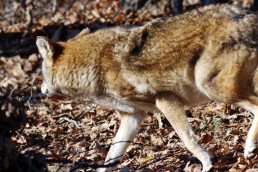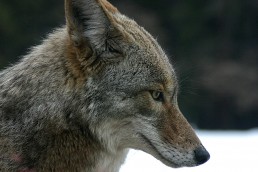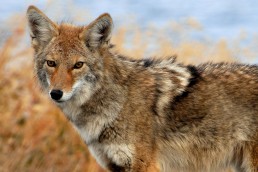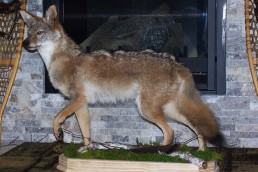Don’t Believe Cartoon Reputations: Coyotes are Wily
SHARE THIS POST
I used to watch Road Runner cartoons when I was a kid. Wile E. Coyote, no matter how hard he tried, never caught the Road Runner. Just when it seemed the villainous cartoon character was within finger’s reach of the speeding, beeping bird, the furry fool would meet with a flattening or bone-shattering object.
In the real wilds, however, much the opposite is true. The coyote is extremely clever, cunning and elusive. The Road Runner–well–he’s a close relative of the cuckoo bird. Enough said. Obviously, a lot of other people are impressed by our resident relative of the wolf. Of all the columns I’ve written during the last couple of years around here, none got as much response as the one I did about coyotes last winter.
In the state of Kentucky, hunters can pursue coyotes at any time of the year and there is no limit on them. During the month of February, you also can use center-fire rifles to harvest coyotes on the Land Between the Lakes.
The seasons and the limits are wide open for a few reasons. One is that nobody really knows exactly how many there are in the state, except that there are a bunch, and that there are too many. Another reason is that few people hunt them, except during January and February when there isn’t much else to hunt. But the main reason is because coyotes are so elusive, and many believe it’s doubtful that even heavy hunting would thin out their numbers.
The late Ed Story was an old friend of mine. Among many other things, including the founding of Feathercraft Fly Merchants, Ed was a furrier who for decades trapped, captured and shot most of his furs himself. He had the highest respect for a coyote’s abilities.
“You can hunt them for a lifetime,” Ed said, “and never learn anything until you learn the ways of the coyote. The best way is to locate den areas and hunt on the trails leading into or out of the dens. They will follow a path in the morning from their den to where they will spend the day, and they’ll use the same path back to their den in the evening.
“During the day they may cover 10 miles at a trot. They could be anywhere in the 10-mile area during the day, so the best way to intercept them is to set up near the den sites early in the morning and late in the evening.”
What coyote hunters like best about the sport is that they can fool them with game calls. This writer is no expert, but he has called in quite a few coyotes while using a fawn bleat, and a bunch of coyotes while using a Mr. Squirrel Call.
Are you enjoying this post?
You can be among the first to get the latest info on where to go, what to use and how to use it!
Most people, however, use calls that mimic a dying rabbit or woodpecker. Recordings of these sounds can be purchased at the larger sporting goods stores and slipped into a cassette player to make it simple. Such “mechanical” calls are legal in Kentucky, and they even became legal on the LBL a few years back.
The best coyote hunters make their own calls. Ed Story simply sucked on the back of his hand to make a squeaking and squealing noise.
Any rifle in the “varmint” category is suitable. Probably most popular is a .243 Winchester. Ed preferred a .22 magnum.
“If you plan to save the pelt, the smaller calibers are best because you don’t make a big hole. I always try to shoot mine in the head,” Story said. “If you don’t desire a perfect pelt, your deer rifle will do. However, you should choose caliber and bullet grain according to terrain. Most shots will be within 100 yards.”
Ed once showed me racks of hanging pelts. Their fur is surprisingly luxurious and beautiful.
“Processing furs to clothing quality is complicated, but anyone can tan a hide well enough to sew it onto felt backing and hang it on the wall of their den.”
MWO
SHARE THIS POST
Did you enjoy this post?
You can be among the first to get the latest info on where to go, what to use and how to use it!
Ron Kruger
Ron Kruger has been communicating the outdoor experience for more than four decades. He has worked as a full-time guide for trout on the North Fork, for crappies and bass on Kentucky Lake and for smallmouths on the Current River. He has served as editor of three outdoor magazines, and owns a patent on a fly/lure called the Desperate Diver.



